The traditional Twitter marketing advice for B2B brands focuses entirely on creating and optimizing content for the company page.
However, we feel that the best way to generate more brand awareness, drive traffic, and increase sales through Twitter is by leveraging your employees’ networks (specifically, executives).
Here are just a few examples of top B2B executives who have a strong Twitter audience that is highly valuable to the brands they work for:
- Ahrefs CMO Tim Soulo
- Stand Together CTO Mark Johnson
- Moz’s Marketing Scientist Dr. Pete Meyers
- Head of Media at Sales Impact Academy Daniel Murray
A single post from any of these executives promoting their product is almost like running a highly targeted influencer marketing campaign.
So in this post, we’re going to show you how you can help your key executives build a loyal following on Twitter and then leverage their profiles to boost your brand’s initiatives.
Identify Key Executives
Some of your key executives might already be active on Twitter, though if not, identify which people would be most influential. Then use the strategy below to help them build an audience on Twitter for B2B marketing.
When choosing which executives to invest in, here are a few factors to consider:
- Does this person already produce some form of content? This could be LinkedIn content, speaking at conferences, webinars, etc. If they already produce content, it’s easier to simply repurpose it, and it also means they understand the value of content marketing.
- Does this person own any stake in the company? If they do, they’ll be less likely to leave the company in the future. Otherwise, you’ll have to start all over again.
- Are the followers of this person likely to become customers? For example, if your brand sells a content marketing tool, building up the CMO’s presence makes sense because your target audience (marketers) probably already follows other CMOs. In contrast, they probably aren’t following, say, CTOs.
Create a Content Plan
Publishing frequency is one of the most important factors of success for any B2B Twitter strategy for a few reasons:
-
Each piece of content is only relevant for a matter of hours – it’s not like SEO where people will consume that piece of content several years from today.
-
Not every piece of content will hit, and the best way to figure out what resonates with your audience is to post consistently.
So how often should you post to social media?
As much as possible while still maintaining quality.
If your executives can post daily, that’s ideal. However, we realize that most executives are also busy running the company, so they might not be able to keep up with this capacity. For this reason, we recommend using a social media scheduling tool that enables executives to create all of their content in one sitting. Then, use a social media scheduling tool that publishes the content automatically throughout the week.
If you’re using GaggleAMP to run your employee advocacy program, this publishing feature is built into the platform:
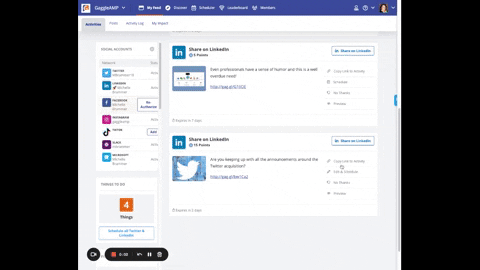
In addition, planning out each executive’s content calendar makes it easier for you to figure out how often you can ask them to push brand initiatives before it becomes overly promotional for their social networks.
Ideally, you want the ratio of promotional content to valuable content to be one to four. If you push company initiatives more than this, the executive’s personal brand won’t seem as authentic.
Craft High Quality Content
One of the top objections we receive when pitching the idea of building executive brands is that their executives don’t have time to post content consistently (or at all).
There are several ways to navigate this challenge.
First, help executives avoid staring at a blank page by giving them a prompt.
GaggleAMP makes this super easy of B2B marketing on Twitter.
You can select the Question card and write one of these prompts for the executive to answer:
- What is a recent industry trend that you’re interested in, and what is your opinion on it?
- What was a recent conversation you had with a peer that you think others would benefit from knowing about?
- What is a recent win that other peers would enjoy learning about?
- What is a failure that you’ve learned a valuable lesson from?
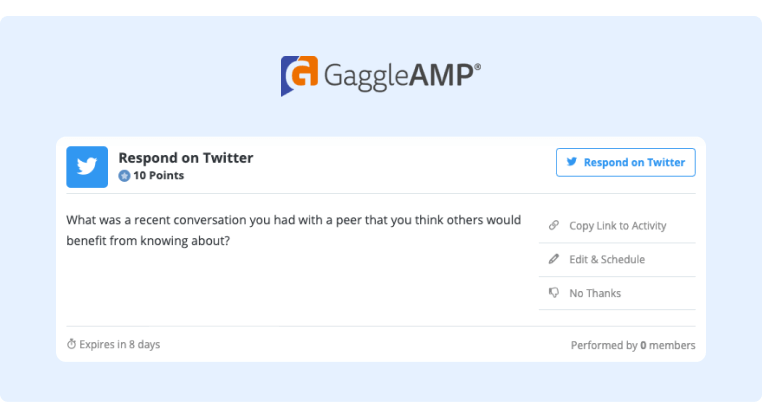
Once the executive completes the post, they can schedule it to go live in the Gaggle (or you can go in and further optimize the copy for engagement and click-throughs):
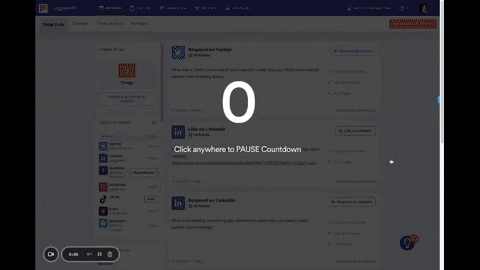
Here’s a great example of a Tweet that could have easily come from a prompt like “What’s a common misconception you see in the marketing industry?”
Know what blows my mind?
— Ross Simmonds (@TheCoolestCool) July 7, 2022
When marketing teams assume "content = blog posts."
Somewhere over the last few years, CMOs and marketers have been tricked by agencies into thinking content = blog posts.
Huge mistake.
Here are some other content types that drive ROI 🧵
Another option is to hire someone to create content for executives. Prominent investor Andrew Wilkinson recently mentioned this idea, and you can see in the comments that many people now offer this as a service.
Idea: A copywriting agency that focuses 100% on Twitter.
— Andrew Wilkinson (@awilkinson) September 6, 2022
Send them notes/a story, they craft it into a hooky Twitter thread.
Is this dumb? What would you pay per tweet thread?
Or, you can interview the executive yourself either monthly or weekly and write threads based on what they have to say. This way, the executive just has to show up to a Zoom meeting once per week or month.
To ensure the posts fit the executive’s tone, you can ask the executive to approve them in the Gaggle and then schedule them to publish.
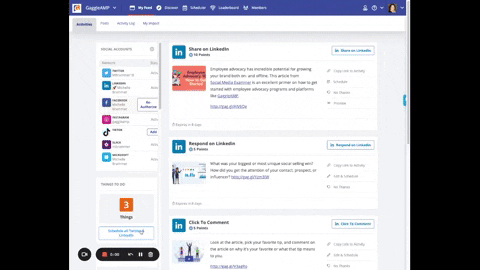
Another option to create high-quality content consistently with minimal effort is repurposing and reposting content that has already performed well.
To repurpose content, look at content that the thought leader has already produced and then repackage it as a Twitter thread. For example, you can take quotes from a webinar/video/talk they did and post them as Tweets. In fact, you can even summarize the entire piece of content as a Twitter thread.
Codie Sanchez has an excellent example of this. She covered how to make money with an ice vending machine in a video and then spun it off into a blog post and a Twitter thread:
I was told you could make $40-71k a year w/ a relatively passive income and $10-20k down?
— Codie Sanchez 💥 (@Codie_Sanchez) March 16, 2022
Ice vending machines... here's what I learned: pic.twitter.com/o1JT410uTy
If you’re really short on time, you can even repost it directly to Twitter. This is a key strategy that Gary Vee uses:
The #morningwalktalk 🌧 pic.twitter.com/OxtX06obh0
— Gary Vaynerchuk (@garyvee) September 7, 2022
One last interesting way to repurpose content is asking executives to record any conversations they have with other colleagues and then (with the other person's permission) post it as a Tweet.
Here’s a great example of this in action:
Guess how much money you get from Youtube for generating 22 million impressions through shorts?
— Kevin_Indig (@Kevin_Indig) September 6, 2022
I guessed $1M and was VERY off!
The answer comes from my brilliant conversation with Eric Siu, in which we brainstormed 6 ideas for growing the largest luxury brand in the world. pic.twitter.com/YVwQQLHd4Q
Finally, to make engaging super easy for executives, look at their Twitter Analytics, see which posts were most popular, and ask them to retweet those posts.
For example, a post like this could easily be updated for 2024:
My Favorite Writings Tools for 2022:
— Easlo (@heyeaslo) September 4, 2022
1. Grammarly (@Grammarly)—Write mistake-free.
2. CopyAI (@copy_ai)—Generate content with AI.
3. Typefully (@typefully)—Write tweets w/o distractions.
4. Hemingway( @HemingwayApp)—Make writing bold and clear.
By selecting a proven format, you don’t have to start over from scratch every time, which significantly increases the probability that it will be a success.
Assign Posts Promoting Key Brand Initiatives
Now that your executives have plenty of high-value content scheduled to go live, you can start sprinkling some brand-centric content into the publishing schedule.
While you can assign executives to share content posted on the brand's Twitter account, we've found that this strategy is usually only minimally effective.
Here's an example of this in action, and you can see that the engagement metrics are modest:
New! Site Explorer > Overview 2.0 > YoY comparison 📈
— Ahrefs (@ahrefs) August 4, 2022
You can now create graphs to see how a target website (incl. webpage/subfolder) has performed year-on-year for its:
- Organic traffic
- Backlinks
- Indexed pages
Have you tried it? Let us know what you think! pic.twitter.com/TrZnf7VJDS
Instead, we've found that it's much more effective to assign an idea and leave executives to create a post promoting the product in their own voice. You can see that this post offering marketing tips using the product is much more popular than the traditional promotional tweet:
5 useful things you can do with @ahrefs SEO toolbar.
— Tim Soulo 🇺🇦 (@timsoulo) August 2, 2022
( 4 of them are FREE ) pic.twitter.com/hy6Jf0NIKe
Interact With Other Twitter Users
By now, each executive is probably naturally earning followers, so the next item on your executives' to-do list is to build a relationship with those people by responding to comments and DMs.
This helps executives build a relationship with their followers and amplifies the engagement on that post as a simple response to every comment doubles the post's engagement and ultimately boosts it in the social algorithm.
Justin Welsh is a great example of a micro-influencer who consistently interacts with his audience:
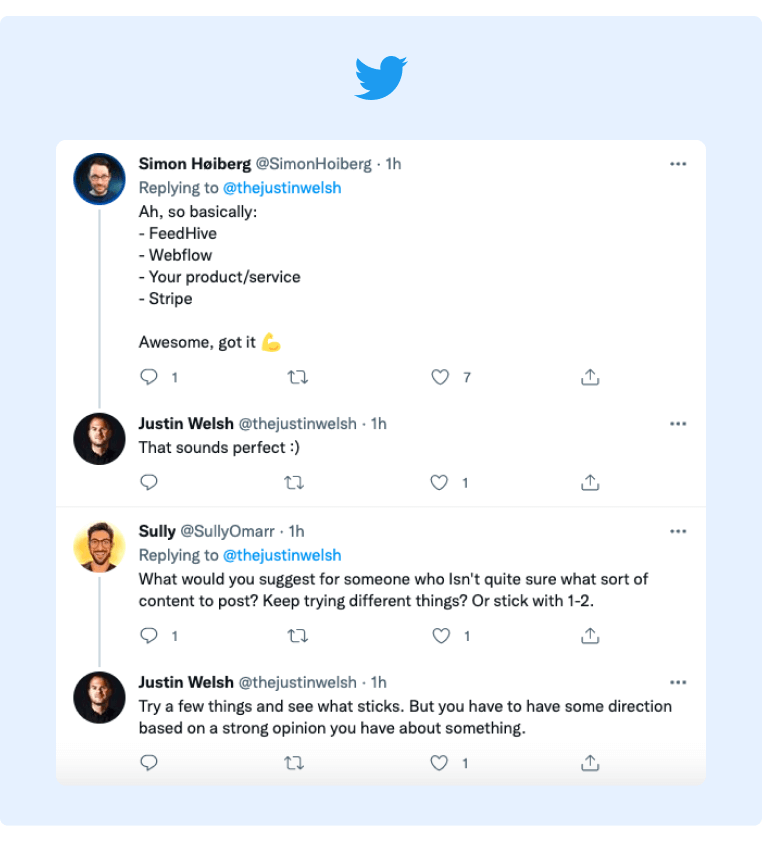 If the executive doesn't personally have time to respond to comments and DMs, someone else on the team can always do it for them.
If the executive doesn't personally have time to respond to comments and DMs, someone else on the team can always do it for them.
To take engagement to the next level, consider identifying a handful of relevant influencers and then have executives consistently engage with those influencers' content.
Over time, executives can build real relationships with these executives, which can lead to collaborations and partnerships that can benefit your brand.
Finally, don't forget that Twitter is teeming with potential customers asking questions about the topic in which your executives are experts. So rather than just posting content and hoping that the right people find it, seek out relevant conversations and chime in with helpful advice.
Hunting down these conversations is time-consuming, so you can use a social listening tool to do the work for you. Most of these tools enable you to enter a relevant keyword, which will alert you (usually via email) when someone mentions that keyword.
This makes it super easy for executives to connect with potential B2B buyers in real time and provide value.
TL;DR: Creating a B2B Twitter Marketing Strategy and Workflow
If you just want the action steps, here's exactly how you can use Twitter for lead generation, brand awareness, and other key metrics.
-
Social media is social. Even if you sell to B2B businesses, your buyers are still people and therefore want to connect with other people. Therefore, work on building your executives' personal brands and then leverage that to promote brand initiatives.
-
Create a content calendar that ensures the ratio of brand initiative to value-focused content is 1:4.
-
Help executives create high-value content by providing prompts or interviewing them and then enabling them to schedule the content to publish at a future date.
-
Define key brand initiatives and create prompts for executives to push those brand initiatives with their own words.
-
Support executives with engagement by helping them respond to comments and tracking critical conversations.
To help you create a workflow that is highly efficient and automates most of the communication, consider using a tool like GaggleAMP.
Here's how it works:
Step 1: You assign an engagement activity to the executive with specific instructions.
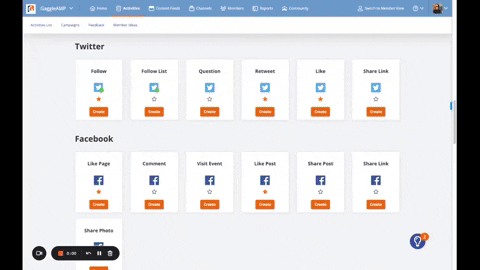
Step 2: The executive receives a notification that they have an assignment. They can enter the Gaggle, complete the engagement activity and schedule it to publish at a future date/time.

Step 3: You can track employee engagement in the analytics dashboard.
To see for yourself how GaggleAMP works, schedule a demo or try it out for free now!


